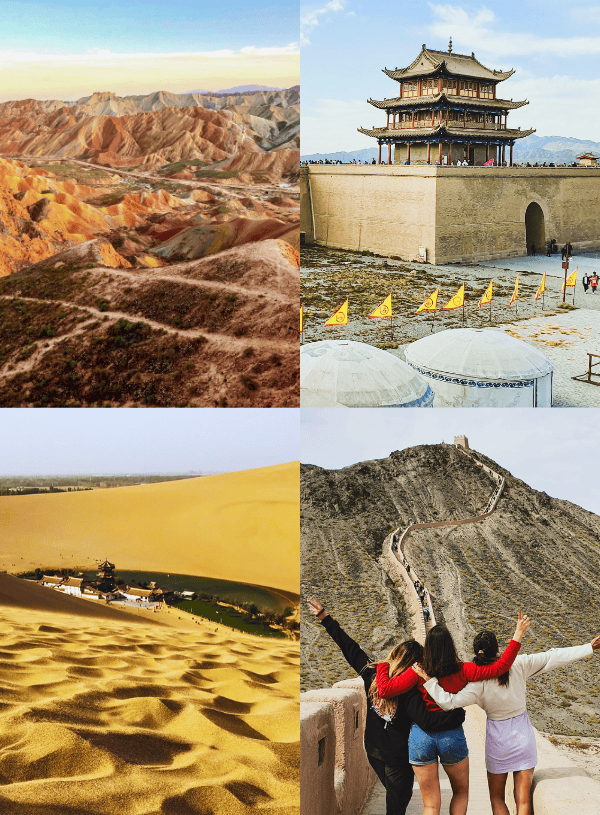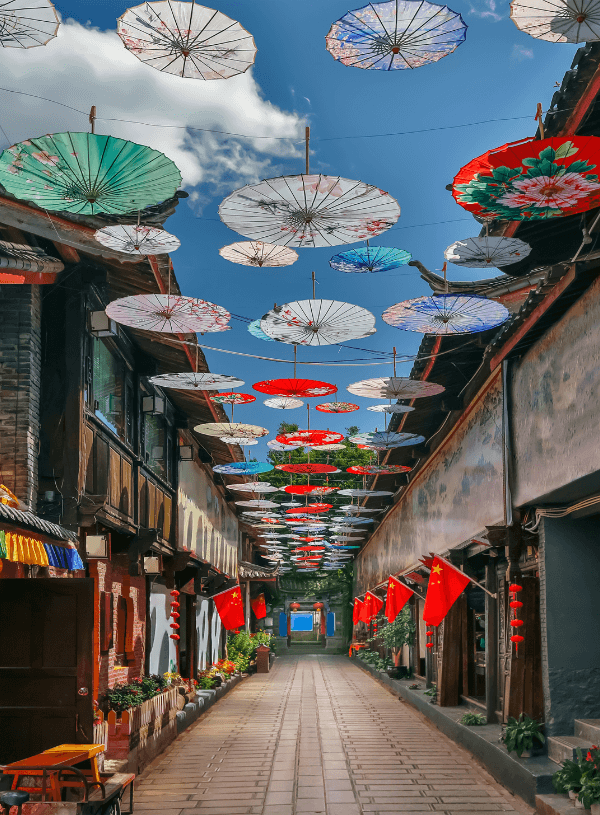The Perfect Hangzhou Itinerary: 2 Days Around the Charming West Lake
Last Updated on June 16, 2025
Will you be heading to eastern China, visiting cities like Shanghai or Suzhou? Then you absolutely can’t miss Hangzhou, just a couple of hours away by high-speed train.
I visited Hangzhou in 2019, after a couple of days in Shanghai, and it turned out to be the perfect 2-day trip if you’re already in the area. Compared to the non-stop energy of Shanghai, the vibe here is so different. Thanks to the charming West Lake, Hangzhou offers a unique, postcard-like landscape, a UNESCO World Heritage Site since 2011.
In this blog post, you’ll find practical tips to plan your stay, plus a 2-day itinerary filled with the best experiences this timeless city in Eastern China has to offer.
This article may contain affiliate links. This means that if you purchase through one of the links, I may be paid a small commission at no extra cost to you. Thank you for supporting the blog and allowing me to keep sharing meaningful travel experiences with you.
Don’t have time now?📌 Save it for later!

Is Hangzhou Worth Visiting?
Yes, no doubt about it… If you’re in the area, a stop in Hangzhou is worth it. Imagine yourself strolling or cycling along the serene West Lake, where nature and traditional Chinese architecture combine to create a picture-perfect scene.
It’s no surprise that visitors from all over China come here to enjoy this view at least once in a lifetime. Even if you’re stopping over from Shanghai or Suzhou, there’s plenty to experience in even a single day.
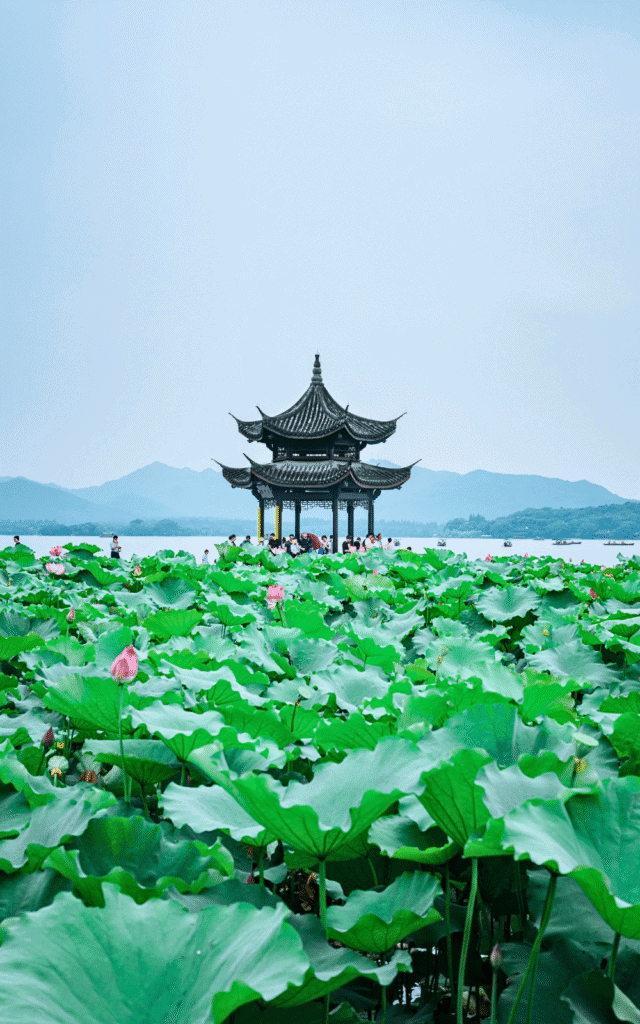
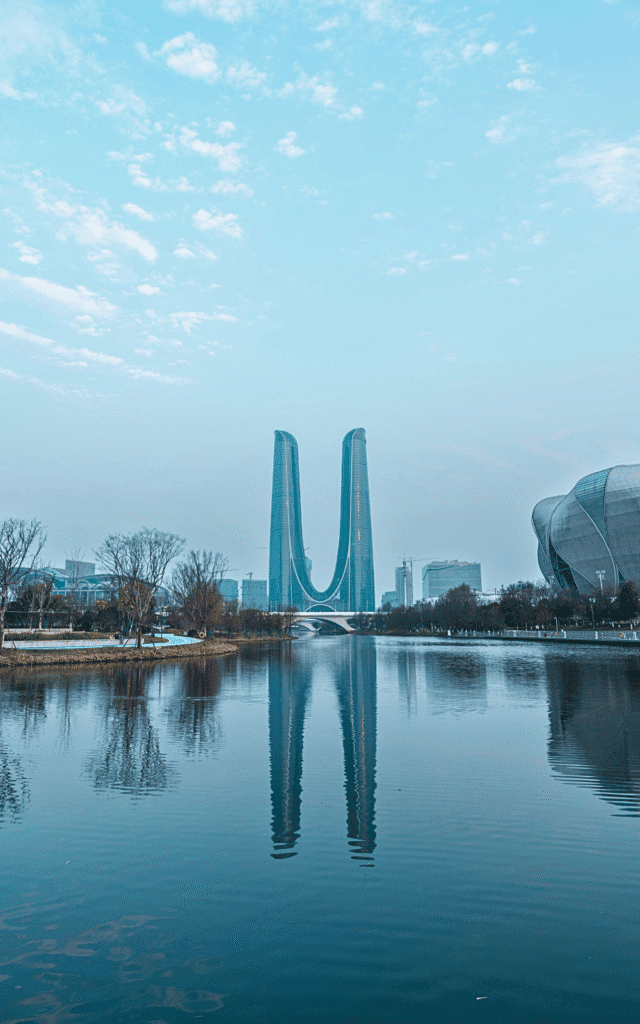
Like many Chinese cities, Hangzhou is a mix of old and new, but here, it feels more balanced. You’ll find traditional streets, charming teahouses, and quiet tea villages all around the hills surrounding the lake, coexisting with the modern city vibe.
What I loved most about Hangzhou was walking along the lakeside, taking pictures of the beautiful pavilions, bridges, and peaceful, hidden corners. If you only have one day, that’s the best way to spend your time here.
Planning Your Trip
1. Key Things to Know
2. Best Time To Visit Hangzhou
I visited Hangzhou in October. While it wasn’t cold, the sky was quite grey, and honestly, that doesn’t do justice to the beauty of the city. Spring, especially April and May, is the best time to enjoy the natural scenery.
Spring in China brings colorful blossoms all over the country, and Hangzhou is no exception. Since the highlights of your trip will likely be West Lake and the nearby tea plantations, visiting in spring guarantees you’ll see them at their best: vivid, vibrant, and full of life.
With milder temperatures, you can even consider taking a boat ride on the lake and enjoy the landscape from a whole new perspective.
3. How Many Days in Hangzhou?
Spending two or three days in Hangzhou is ideal to explore the city without feeling rushed.
If you’re planning to see all the main sights around the West Lake, I suggest dedicating a whole day just to that; it deserves it.
Then, depending on how many other spots you want to explore beyond the lake, you might want to add an extra day. This way, you can truly enjoy everything Hangzhou has to offer at a relaxed pace.
4. How to Get to Hangzhou?
You can easily reach Hangzhou by high-speed train. It’s just about an hour from Shanghai and up to two hours from Suzhou, which makes it perfect for a quick day trip.
From the train station, you can easily take a taxi or book a DIDI to your accommodation if you’re staying overnight, or to the West Lake if you’re there for the day.
To book your tickets, I recommend using Trip.com. It’s my go-to platform for train travel in China and is super easy to use, even if you don’t speak Chinese.
5. How to Get Around in Hangzhou
Hangzhou is a popular tourist destination in China, and getting around is very easy thanks to the wide range of transport options. Besides the usual public transport, like the metro (with 12 lines), buses, and taxis, you’ll also find more fun ways to move around, including water buses along the Grand Canal and lake cruises.
Public transport in Hangzhou reaches pretty much every corner of the city, including waterways. And even if you don’t have a destination in mind, hopping on a water bus can be such a unique way to explore the ancient waterways and see the city from a different angle.
In Hangzhou, there are four water bus lines, and if you’re wondering which one to try, Line No. 7 was voted the most beautiful water bus by locals in 2023. You can also take a West Lake cruise to enjoy the different scenic spots around the lake. Lake cruises don’t operate from October to June, and you can purchase your ticket at Wulinmen Pier, where all cruises take off.

6. Where to Stay in Hangzhou
In my opinion, the best place to stay in Hangzhou is around West Lake, especially on the eastern bank.
Here, you get the best of both worlds: beautiful lake views and access to the city center. You’re also close to Wulin Square, with its shopping malls, restaurants, and all the facilities you might need. The railway station is located further east, which is a plus if you’re arriving or leaving by train.
There’s a wide range of accommodation options here: not just upscale hotels, but also plenty of more budget-friendly choices. Here are some good hotel options:
Hangzhou Lanshe Hotel: This is a great accommodation option, just a short walk from both the lake and the nearby shopping malls. The staff is incredibly helpful, and the rooms are spacious, cozy, and comfortable, which makes a difference after a long day of exploring.
Mutao Hotel: This hotel is also in a great location, a quiet neighborhood that’s still close to the lake, main attractions, public transport, and a shopping center. The staff is super helpful, and one of the team members speaks English, which makes things a lot easier if you don’t speak Chinese.
EBO Hotel (Hangzhou West Lake): Located in the city center, just a short distance from the shopping malls and the train station, and still close to West Lake, this hotel is another great place to stay in Hangzhou. The breakfast is a highlight, and both the room quality and overall service are perfect!
7. What & Where to Eat in Hangzhou
What to Eat
You simply can’t visit a new Chinese city without tasting some of the local specialties! Thanks to its proximity to the lake, fish and shrimp are definitely staples in Hangzhou cuisine, but you’ll also find plenty of delicious meat-based dishes, especially featuring pork and chicken. Below some of my favorite dishes you can try:
Braised Dongpo Pork: I absolutely love the way pork is cooked in China, and Dongpo Pork was hands down one of the best things I tried in Hangzhou. The meat is slow-braised for hours in a rich mix of soy sauce, Shaoxing wine, sugar, and ginger, until it becomes tender, juicy, and flavorful.
Fried Shrimps with Long Jing Tea: It features fresh river shrimps, stir-fried and then infused with the aroma of Long Jing (Dragon Well) tea, which is grown right in the hills around West Lake.
Beggar’s Chicken: This is one of the most traditional dishes you can try in Hangzhou. The whole chicken is marinated with herbs and spices, then wrapped in lotus leaves, sealed and slowly baked. The result is a tender and aromatic chicken.
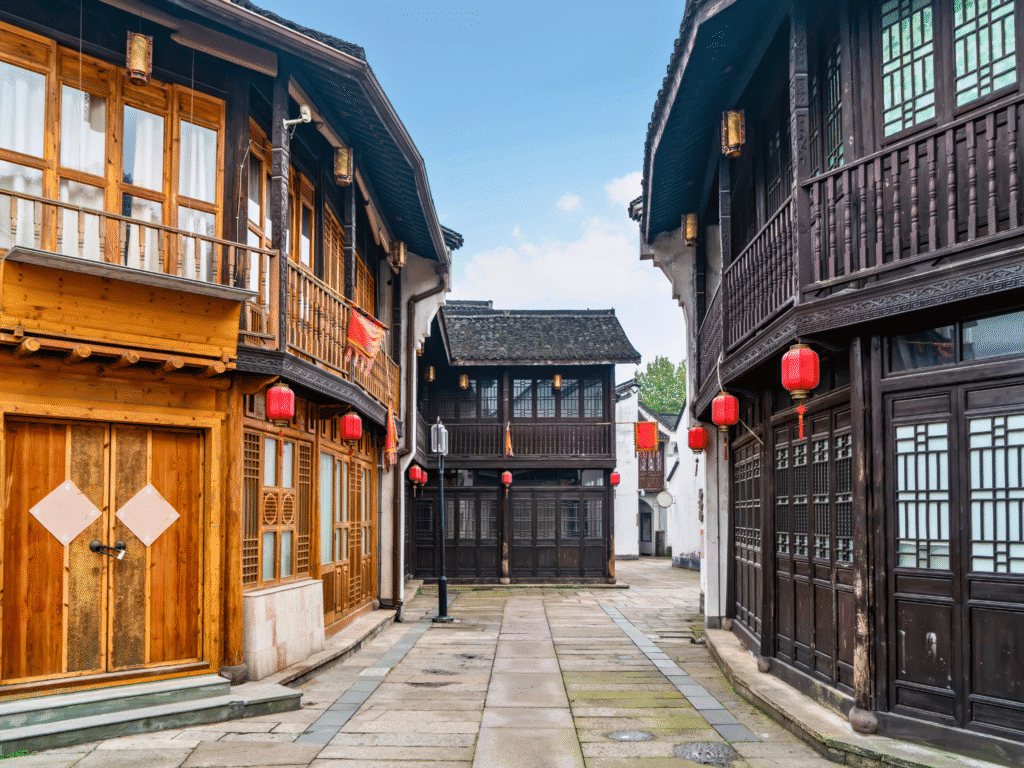
Where to Eat
As in every Chinese city, there are some specific areas in Hangzhou where you just know you’re going to find great food. If, like me, you love walking around and food hunting without too many plans, just head to these spots and follow your nose; there’s always something delicious cooking somewhere!
West Lake Scenic Area: Of course, around the lake, you’ll find plenty of restaurants that combine great food with beautiful lake views. Near sights like the Lingyin Temple, Leifeng Pagoda, or the Longjing Tea Plantation, you’ll come across lots of local spots where you can sit and enjoy a meal with a view.
Hefang Street: Hefang Street is one of the classic, traditional streets in the city, dating back to the Song Dynasty. If you’re after street food snacks and a truly local experience, this is definitely the place to go.
Hedong Road: This is another great spot for dinner in Hangzhou. Here, you’ll find not only Zhejiang cuisine but also dishes from Sichuan and other regions. If you’re after a lively vibe, head to the southern end of the street where street food stalls are open till late at night.
If you’re looking for more information about traveling to China, make sure to check out my comprehensive (and constantly updated) China Travel Guide. It covers all the logistical details you might need to plan your trip, from transport tips to practical advice for first-time visitors.
Hangzhou Itinerary Map
Tickets & Tours in Hangzhou
Day 1: Lake Views, Tea Villages & Old Street Charm
1. West Lake Riverside
The riverside of West Lake truly deserves your time (at least half a day). It offers unforgettable views, natural beauty, and what many consider the essence of classical Chinese elegance. Surrounded by lush green hills on three sides, you’ll still catch Hangzhou’s modern skyline with its skyscrapers on the fourth.
Unlike Shanghai, Hangzhou is one of those rare places where, standing by the lake, you can almost forget the modern city just beyond.
As a UNESCO World Heritage Site (the only lake in China to hold this honor), West Lake holds a unique place in Chinese culture and history. Its design, full of gardens, pagodas, ponds, bridges, and pavilions, has inspired traditional gardens not only across China but also in Japan and Korea.
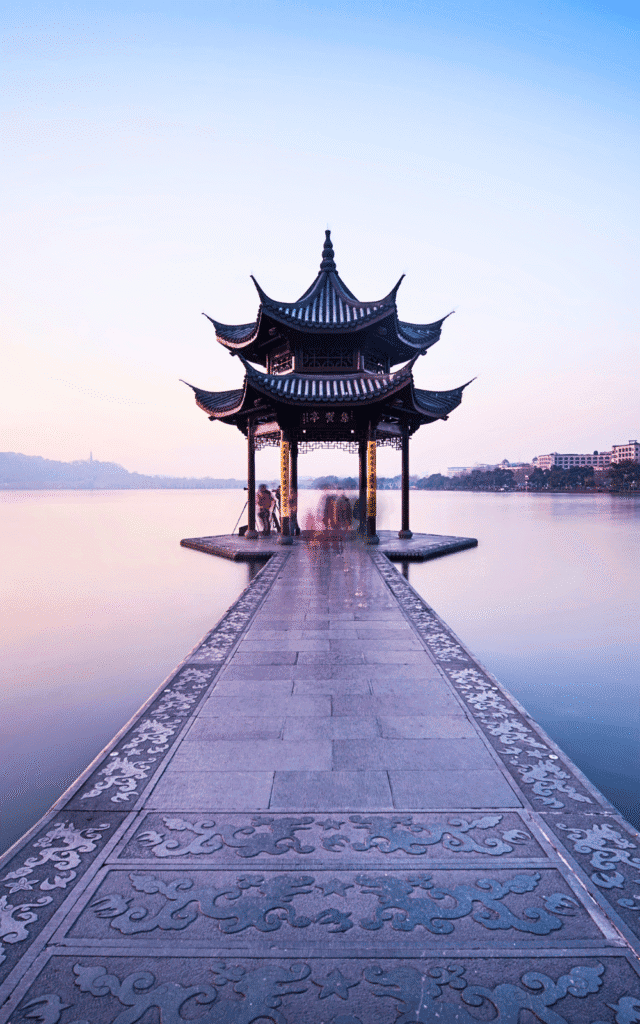
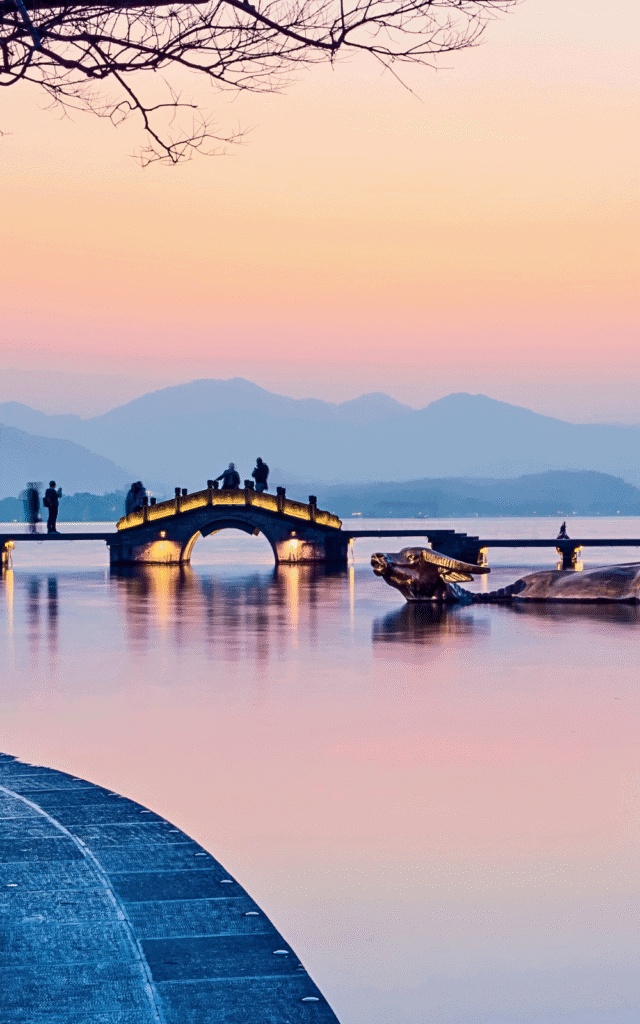
If you’re wondering where to start exploring the lakeside, I recommend checking out the “Ten Scenes of West Lake”, the ten most beautiful views, each named with poetic Chinese titles that capture their idyllic charm.
If you’re short on time, don’t miss the Su Causeway, a path lined with willow trees and bridges. And visit the Three Ponds Mirroring the Moon, where three tiny islets create one of Hangzhou’s most peaceful scenes.
2. Longjing Tea Village
Whether you’re a tea lover or not, visiting Longjing Tea Village is a beautiful way to connect with one of the area’s most traditional activities: growing tea leaves.
This green village is where locals grow the famous Longjing Dragon Well tea (the one used to prepare the Shrimps), and if you visit in spring, especially between March and May, you might catch farmers hand-picking fresh tea leaves.
If you’re into photography, try visiting in the afternoon when the golden light hits the tea fields. The easiest way to get there is by taxi, which saves you the trouble of figuring out the bus system.


Once you’re there, you’ll find plenty of little teahouses where you can sip freshly brewed Longjing tea while soaking in the view over the tea plantations.
And if you’re up for some movement, the area around is perfect for trekking. One of the best routes is the Shililangdang trail, which connects Meijiawu Village to Longjing Village. It’s only about 3 km, and the walk takes around an hour or so, nothing too intense, just enough to fully enjoy the scenery and clear your mind.
Another super fun way to spend time here is to join a local tea experience: you can try picking the tea leaves yourself, learn how to roast them, and join a tea tasting while hearing stories about tea culture and traditions.
3. Qinghefang Old Street
Qinghefang Old Street is one of the places in Hangzhou where you can still feel the pulse of ancient China. In a country where so much gets modernized or rebuilt, finding something this well-preserved feels like stumbling upon a beautiful rarity.
Back in the Song Dynasty, this street was the heart of Hangzhou: a trade centre with plenty of teahouses, apothecaries, restaurants, and shops. And the fantastic thing is that some of those same businesses are still here today, after centuries.


What I love most about Qinghefang is how it gives you an idea of what life might have looked like back in the day, while still being vibrant and full of energy.
It’s the perfect spot for a relaxed evening stroll past vintage storefronts, grabbing some traditional snacks, and sitting down for a delicious Southern-style dinner.
If you go, make sure to stop by some of the most iconic shops in the area: Baohetang Pharmacy, Wang Xing Ji Fan Store, Zhuangyuanguan Restaurant, and Taiji Teahouse.
Day 2: Temples, Pagodas, & Song Dynasty Town
4. Lingyin Temple
Lingyin Temple, also known as the Temple of Soul’s Retreat, is located northwest of West Lake. It’s considered one of China’s ten most famous Buddhist temples, and for good reason; the blend of Buddhist architecture and the surrounding nature creates a calm and inspiring atmosphere.
At its peak during the Five Dynasties, the temple’s grounds were massive, with nine buildings, eighteen pavilions, and enough space to host over 1,000 monks. Though much of its appearance has changed over the centuries, including restorations and damage from wars, the temple’s aura remains just as powerful.
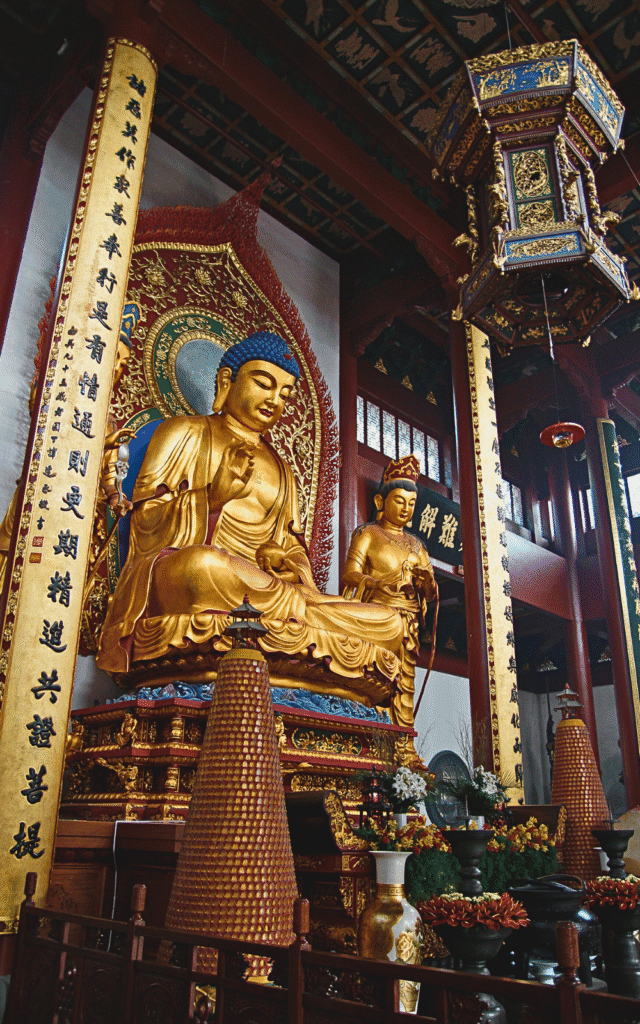
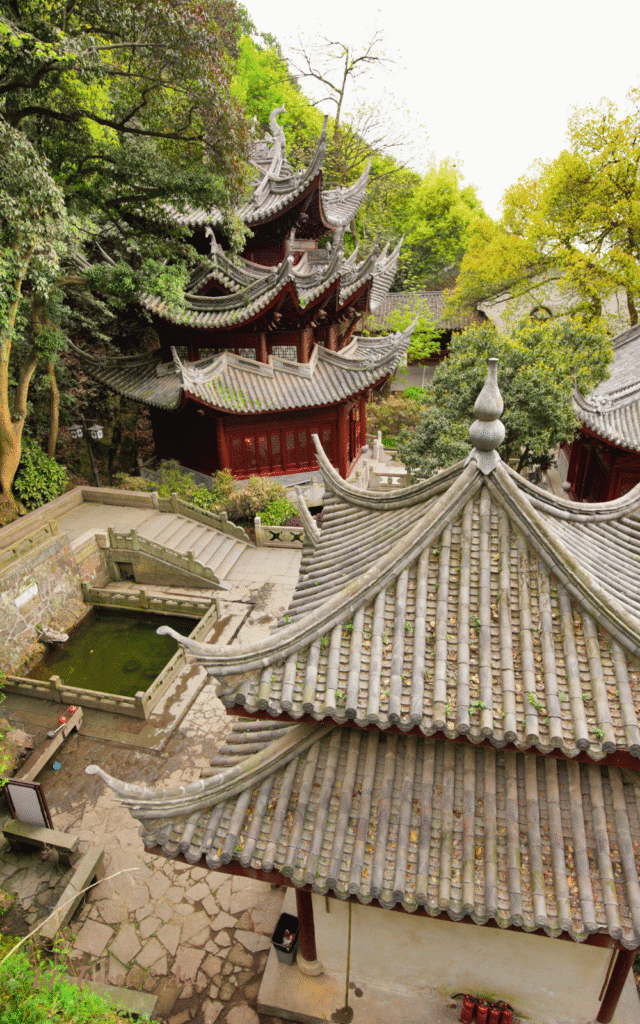
If you’re into Buddhist architecture, this place offers incredible sights. The Hall of the Heavenly Kings features a smiling Maitreya Buddha, while the towering Sakyamuni statue stands nearby. As you wander, you might even come across ancient Buddhist scriptures written on thin patta leaves, carrying centuries of spiritual teachings.
As I always say, it’s good to check out at least one Buddhist temple in every Chinese city, and in Hangzhou, Lingyin Temple is the one.
To access Lingyin Temple, you’ll need to purchase a ticket for the Fei Lai Feng Peak area (and if you have extra time, don’t rush; there’s so much more to explore in the area). It’s recommended to buy tickets in advance to avoid the risk of them being sold out on the day of the visit. You can reach the peak area by taking a taxi.
5. Six Harmonies Pagodas (Liuhe)
I seriously can’t get enough of pagodas. I’ll spend ages just staring at them, snapping a million photos; there’s something about their structure that always pulls me in.
The Six Harmonies Pagoda is located south of West Lake and offers an incredible view of the Qiantang River.
It’s one of Hangzhou’s three famous pagodas, alongside Leifeng and Baochu, but what makes this one extra special is its location right by the river and its impressive height.
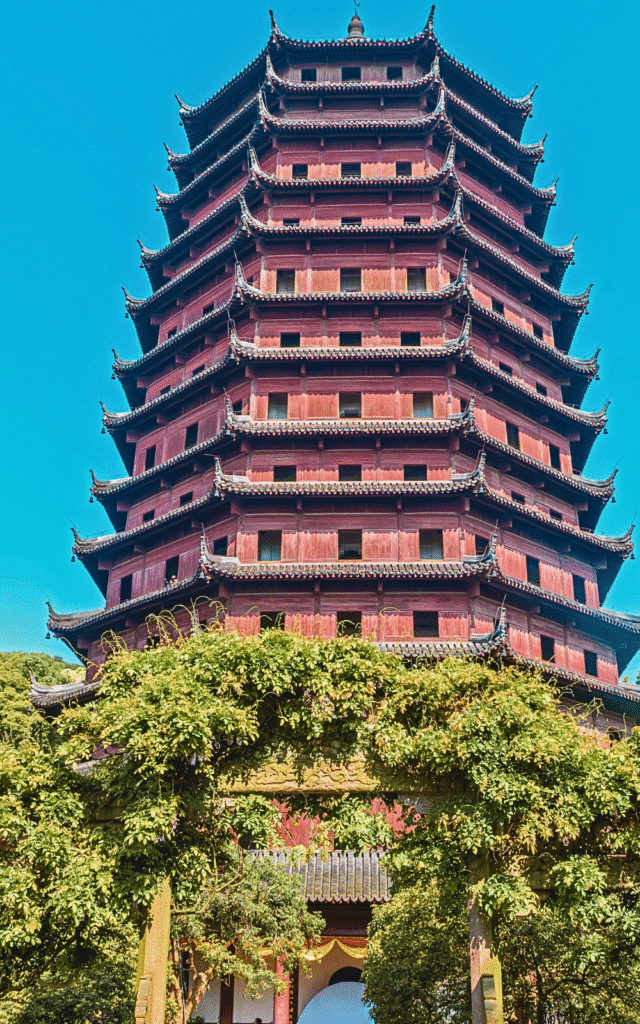
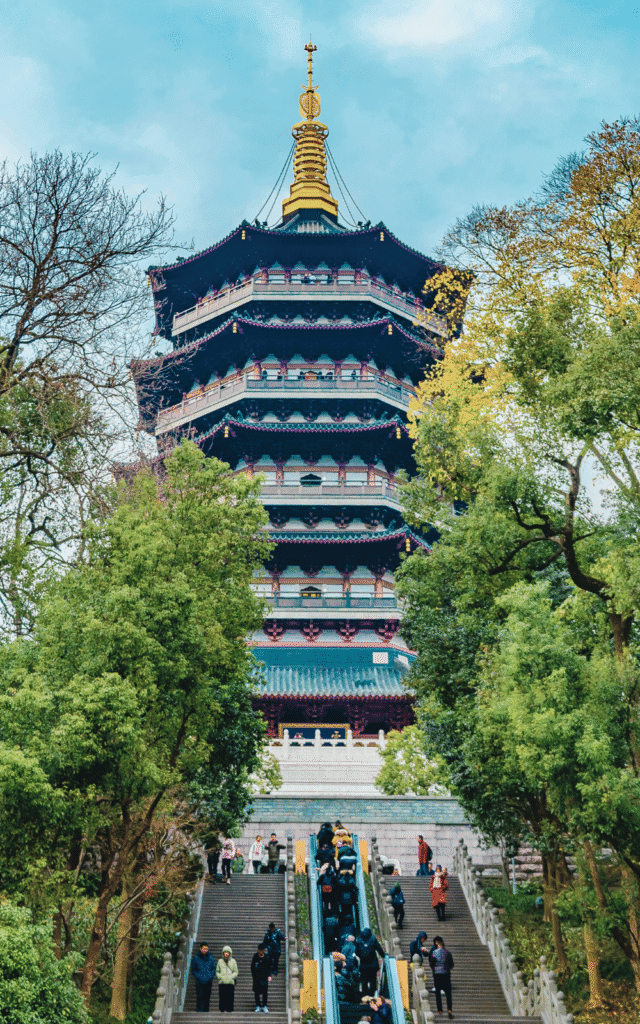
At 60 meters tall, from the outside it looks like a 13-story pagoda, but inside, you’ll find seven floors open to visitors. Each floor has little windows perfect for photos, with stunning views of the river and green mountains surrounding the lake.
Nearby, there’s China’s Pagodas Garden, where you can wander among mini versions of some of the country’s most iconic pagodas, like the Big Wild Goose Pagoda in Xi’an. The easiest way to get there is by taking a taxi; tickets can be purchased directly on site.
6. Song Dynasty Town (Songcheng)
Song Dynasty Town is the very first theme park dedicated to the Song Dynasty. It’s tucked between Wuyun Mountain to the north and West Lake to the northeast.
When I say that some scenes in China look like they came straight out of classic paintings, this place is the perfect example. The famous painting Along the River during the Qingming Festival by Zhang Zeduan inspired the park’s design and layout.
The town is divided into three distinct areas, each offering a unique way to experience the Song Dynasty, blending tradition with a modern perspective: Performing Songcheng, High-tech Songcheng, and Cultural Songcheng.
In Performing Songcheng, you can catch The Romance of the Song Dynasty and other fun shows. High-tech Songcheng brings history to life with innovative tech features, including digital displays. Finally, Cultural Songcheng offers a glimpse into real traditional life, featuring folk activities, workshops, cultural performances, and even Buddhist temples to explore.
If you’re planning a first-time trip to Hangzhou, these would be the sights I’d highly recommend. Honestly, my advice is not to pack too much into one day, as I love saving time for aimless wandering.
There’s so much beauty in the simple daily moments of life in China, and filling my days with sightseeing sometimes gives me FOMO for that experience. With that in mind, if you have 3 or 4 days in Hangzhou, here are a few spots you can add to your itinerary.
Other Things To Do in Hangzhou
1. Leifeng Pagoda
Leifeng Pagoda is a spot I’d add to my itinerary, mainly for its panoramic view of West Lake from the south shore. The pagoda you see today was rebuilt in 2002 on its original foundations. It’s a famous symbol of Hangzhou, mainly because of its role in the “Legend of the White Snake“, a well-known Chinese folktale where a snake spirit is imprisoned beneath it.
2. Baochu Pagoda
If you find yourself with a spare morning and don’t mind a hike, I’d suggest heading to Baochu Pagoda. The hike up Precious Stone Hill through its leafy paths is a beautiful part of the experience. The pagoda itself feels authentically ancient, and the whole area seems less like a major tourist spot and more like a local secret. While it’s a bit of a climb, the view from this less-crowded angle is worth the effort.
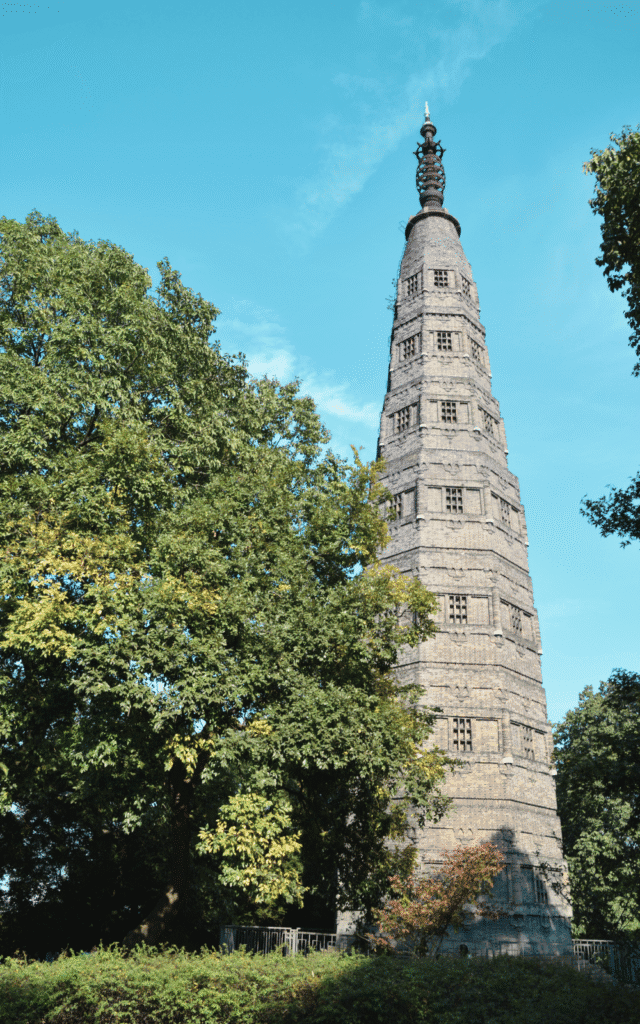

3. Grand Canal
If you have an extra afternoon and want to see a side of Hangzhou beyond the lake, I’d recommend exploring the Grand Canal. It’s a historic waterway that was once the city’s most important resource, connecting Beijing to Hangzhou.
My advice is to head to the area around Gongchen Bridge. From there, you can wander along the canal banks and explore the surrounding historic streets for a glimpse into the daily life of Hangzhou, away from the main tourist trail. Check out Xiaohe Street for a charming traditional street.
Extend Your Itinerary
If you have around 7 days in the Hangzhou area, there are plenty of ways to extend your trip. Suzhou is just 2–3 hours away by high-speed train, and with its laid-back water town vibe, it makes the perfect next stop.
Another nearby city, a bit underrated but definitely worth a visit, is Nanjing. As one of China’s four ancient capitals, it’s full of history, beauty, and character.
You could also put together a perfect 7-day itinerary that covers four cities: so close, yet so different: Shanghai, Suzhou, Hangzhou, and Nanjing. The exact itinerary I took back in 2019 when I visited Hangzhou.
I hope this 2-day Hangzhou itinerary helped you get an idea of how to plan your trip and make the most of your time in this beautiful city. Whether you’re into nature, history, tea culture, or love strolling by the lake, Hangzhou will be able to capture your heart.
If you’ve already been, let me know in the comments what you loved the most, or if you’re planning your trip, feel free to ask any questions!
Did you find it helpful? 📌 Save it on Pinterest!
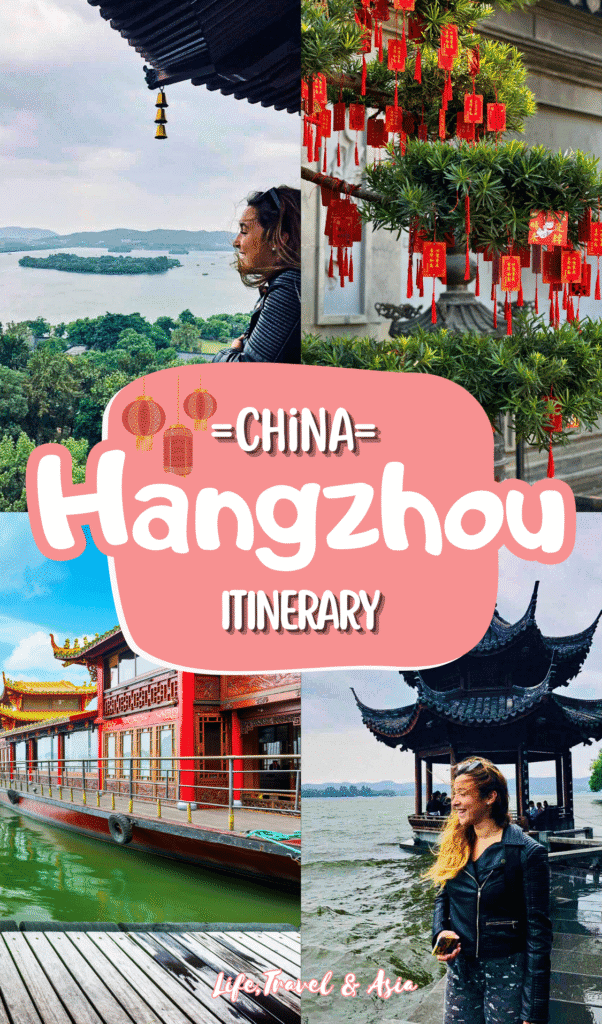
DISCLAIMER: This Hangzhou itinerary is purely based on my experiences and thoughts and is meant to inspire and provide advice. Feel free to adapt it to your preferences—there is no need to follow it in detail. All prices, transport options, and instructions mentioned reflect my knowledge during writing and may have changed since. You must double-check all the information before your trip to ensure accuracy. All opinions and recommendations are my own, rooted in my unique journey through China.


